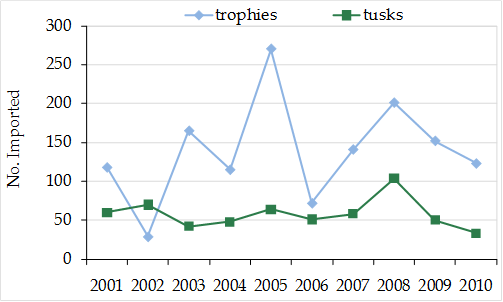2010 Summary for Loxodonta africana (Annex A) (African Elephant)
Criteria met: High volume (globally threatened)
Principal trade term to the EU: carvings, trophies
Principal source: carvings: pre-Convention; trophies: wild
Top EU importer: carvings: United Kingdom, France; trophies: France
Top Trading Partner: carvings: United States, Switzerland; trophies: Tanzania
CITES Appendix: I (except for the populations of Botswana, Namibia, South Africa and Zimbabwe, which are included in Appendix II for specified purposes)
IUCN Status: Vulnerable

EU-reported imports of wild-sourced (includes sources ‘W’, ‘U’ and source unspecified), Annex A Loxodonta africana trophies and tusks (excluding tusks reported in kg), all purposes, 2001-2010.
EU-reported imports from Annex A populations in 2010 principally comprised wild-sourced hunting trophies and tusks (123 and 33, respectively), and pre-Convention ivory carvings (581 carvings and 320 kg of carvings). The wild-sourced hunting trophies mainly originated in Tanzania (41%), Cameroon (28%), and Mozambique (26%).
Wild-sourced trophy items in trade that can easily be equated to individuals consisted of 123 trophies, 33 tusks and two tails. Using the conversion factor of 1.88 tusks per elephant[1], this equates to approximately 143 individuals. A permit analysis of importer-reported data revealed that the two tails were each imported on the same permits as other trophy items, possibly reducing the number of animals involved to 141.
Imports of both Annex A tusks and trophies decreased in 2010, continuing the downward trend seen in 2009. Imports of Annex A tusks (reported by number) in 2010 were the lowest reported over the ten-year period 2001-2010.
In 2010, there were several instances where a L. africana import originating in a country with an Appendix I/Annex A population was reported as Appendix II/Annex B: Finland reported the import of two wild-sourced trophies directly from Tanzania, and Germany reported the seizure of a total of several items exported directly from Nigeria, Tanzania and Kenya.
Trade in L. africana is closely monitored through the CITES process following Decision 14.78 (Rev. CoP15). The SRG formed a negative opinion for Cameroon on 23/02/2012 and confirmed the positive opinion for Tanzania.
[1] Parker, I.S.C. and Martin, E.B. (1982). How many elephants are killed for the ivory trade? Oryx 16 (3): 235-239

